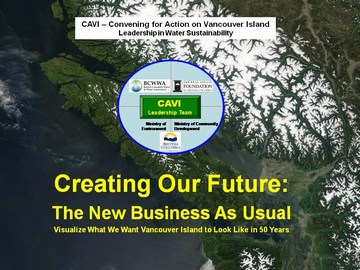Creating Our Future: Convening for Action on Vancouver Island

Year Two Programs
In 2008 (Year Two), Convening for Action on Vancouver Island (CAVI) implemented four program elements that built on the foundation provided by the Year One program:
- June/July 2008: The Cowichan Valley Regional District hosted the Cowichan Valley Learning Lunch Seminar Series because it provided an inter-governmental and inter-departmental opportunity for collaborative exploration regarding effective implementation of green infrastructure. Living Water Smart, BC’s Water Plan provided the backdrop for aligning regional and local actions with provincial policy goals to create liveable communities and protect stream health.
- September/October 2008: The Showcasing Green Infrastructure Innovation in the Capital Region comprised three one-day events – in the Town of View Royal and City of Langford, and at the University of Victoria. The series featured projects that demonstrate what is meant by The New Business As Usual, and set provincial benchmarks for others to measure themselves against. The series was about establishing expectations to truly achieve ‘design with nature’ outcomes at a community scale.
- September – November 2008: The City of Courtenay hosted the Comox Valley Learning Lunch Seminar Series because Council recognized that a common understanding of challenges and solutions would result in consistent expectations at municipal front counters across Vancouver Island. Council also recognized that hosting the series would have a better payback than selectively sending a few staff to conferences.
- October 2008: The purpose of the Cowichan Valley Water Balance Model Forum was to inform, educate and enable those who wish to apply the Water Balance Model to support a ‘design with nature’ approach to land development. Willing land development proponents developed three case study applications that were shared at the Forum.
 “The CAVI vision for the Year Two Program was to play an integrating role, cut across disciplines and ultimately serve as a catalyst to create neighbourhoods that integrate both good planning and innovative engineering designs, for overall greater sustainability….environmental, social and economic,” reported Kim Stephens.
“The CAVI vision for the Year Two Program was to play an integrating role, cut across disciplines and ultimately serve as a catalyst to create neighbourhoods that integrate both good planning and innovative engineering designs, for overall greater sustainability….environmental, social and economic,” reported Kim Stephens.

